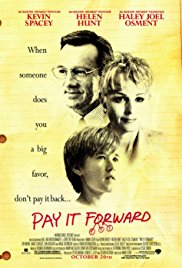Using common sense and standard concepts of ethics education, let’s analyze some of the situations in the film in which a character tried to pay it forward.
1. Bringing a Homeless Man Home: Trevor invites a homeless man to eat, shower, and sleep at the house that Trevor shares with his mother. Trevor knew nothing about this man, called Jerry in the movie, except that he was homeless. It turned out that Jerry was a drug addict. That’s not surprising. A significant number of homeless people are drug addicts. Drug addicts often steal to support their habit. They steal from anyone, including their best friends, their families, and people who try to help them. A drug addict trying to get money for a fix is a dangerous person. Trevor put himself and his mother at serious risk by inviting Jerry into the house. Trevor also made his mother and himself vulnerable to physical or sexual assault.
The flaw in Trevor’s decision was that he didn’t think through how his actions affected his own values and those of the other stakeholders in his decision, such as his mother. Focused on paying it forward and being caring to Jerry, Trevor forgot to take care of his mother and to respect her value of having security and privacy in her home. This is a typical failing for a young teenager. A mature person might have realized that the decision to bring Jerry home involved a conflict among ethical values (caring for Jerry vs. caring for himself and his mother and respecting his mother’s values of security and privacy). Trevor should have applied what we call The Rule of the Most Honoring Choice to help him sort out what he should do.
Another flaw in Trevor’s thinking was that in his rush to do a good deed, he failed to consider other, safer, more effective alternatives. Determining the effectiveness of a plan of action is an important element of any ethical decision. There were safer and more effective ways for Trevor to help the homeless. Certainly Las Vegas has people and agencies experienced in helping drug addicts and those on the street. Trevor could have volunteered to work for one of those agencies, compromising neither his own safety nor that of his mother.
In the movie, Jerry didn’t steal from Trevor or his mother, nor did Jerry hurt them, but that was sheer luck. It had more to do with Jerry’s internal cycles and the fact that he wasn’t desperate for a fix during that particular time.
2. Giving a Homeless Man Money for Clothing: Many homeless are addicts. When most addicts are given money, they use it to buy more drugs. The money ends up furthering their addiction, not helping them. Again, if Trevor had wanted to befriend and help a homeless person he should have worked through an established program with a proven track record. Ethical decisions are effective decisions and this action failed that test. At the very least he could have purchased the clothing and given it directly to Jerry.
3. Aiding and Abetting the Escape of a Criminal Fleeing the Police: Trevor’s grandmother “pays it forward” by helping a thief flee from the police. Her actions fail the Golden Rule. What if someone had hurt or stolen from Trevor or her daughter? She also breaks the law and violating the ethical precept of responsibility. In addition, if asked, the grandmother certainly would not want everyone to help people fleeing from the police. Her actions fail the test of universality. The grandmother was an alcoholic and apparently high at the time. Alcohol not only dulls a person’s reflexes but it impairs their ability to make judgments. Obviously, the grandmother’s decision was not well-thought-out and cannot be condoned.
4. Giving a Jaguar to the Reporter: The reporter didn’t need a Jaguar; he needed a ride and, at most, reimbursement for the deductible on his car insurance. Anything more was an unnecessary gift to the reporter’s insurance company which had already figured the loss in its underwriting and had already collected premiums to cover that loss. If the owner of the Jaguar wanted to help people, he could have helped many more people who were much needier by giving the reporter a ride, paying his deductible, and selling the Jaguar. He could have used the extra money to fund a shelter for the homeless or to contribute to famine relief. Think of how many lives he would have been able to affect. In his rush to make the dramatic gesture of giving the car to the reporter, the lawyer ignored the values of these other stakeholders.
5. Shooting Up the Hospital to Get Care for a Girl Having an Asthma Attack: What about the risk that a ricochetting bullet would hit someone and kill or injure them? What about all the people frightened half to death by the shooting? In the rush to help one person, the man with the gun ignored the values of all the other people in the room. What about the law that prohibits these types of actions and his responsibility to obey those laws? There must have been a better way to draw attention to the plight of the asthmatic girl (effectiveness again). Or what of the gunman’s duties to himself to keep his freedom and stay out of jail? Those are important values as well and he himself is a stakeholder.
This scene plays into the fantasies of every person who has waited too long in an emergency room. It’s well-acted, well-directed, and quite funny, but the shooter’s method of paying-it-forward certainly shouldn’t be emulated.
6. Trying to Help Mom by Setting Her Up with the Teacher/Trying to Help a Lonely Man Find Love with Trevor’s Mom: “Paying-it-forward” is supposed to be motivated only by a desire to help another person. However, one of Trevor’s “pay-it-forward” actions was primarily motivated by self-interest. Trevor wanted a real dad and an intact (or as close to intact as possible) family. He wanted someone in the home to protect his mother and himself from his alcoholic, abusive father. Trevor’s actions are classic ploys by an unhappy child trying to fix his dysfunctional family. While he genuinely believed that his mother and Mr. Simonet would be happy together, his actions were not selfless. But then again, does every good deed have to be self-less?
7. Jerry Fixing Arlene’s Truck. This was a good example of “paying-it-forward” except that Jerry should have told Arlene in advance. He almost got himself shot. On the other hand, it could be said that he was simply paying her back for Trevor’s hospitality.
8. Jerry Convincing the Woman Not to Jump Off the Bridge. This also a good example of “paying-it-forward.” It also makes the point that saving someone else’s life might just start you on the road to saving your own, although there’s always much more to saving your own life than helping someone else.



